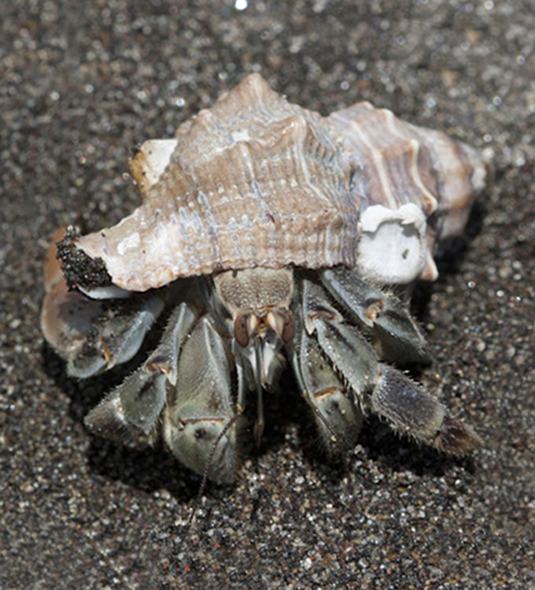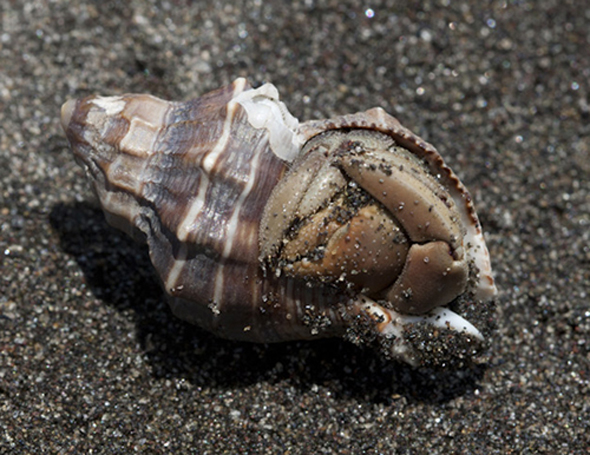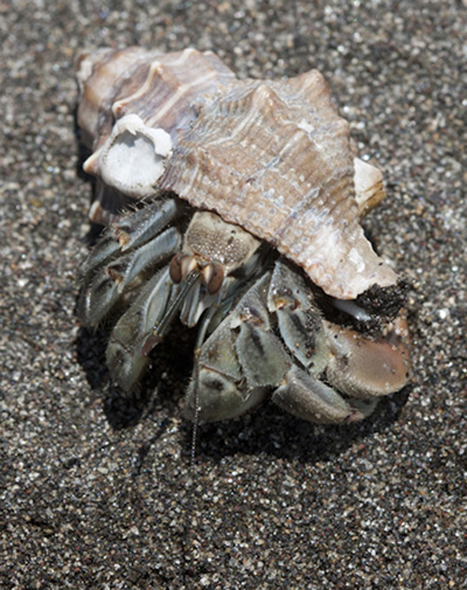Long range project in Maya iconography and zooarchaeology:
Identifying the shells associated with God N
God N, an elderly character enclosed in a snail or conch shell.
In Maya iconography there are trends and fads, so various deities get one name for a few years, then another name a few years later. So it is more conservative just to call the characters as God N, so that it is clear who we are speaking about. Otherwise, depending on the century and author’s circle of admirers, God N is also called Pauahtun, Bacab, or other names.
In rare instances at Chichen Itza, God N is backed by a spider web. In several representations God N is emerging from a turtle shell. But normally God N can be in a conch shell or snail shell. Some representations of a deity are occasionally associated with a bivalve shell.
Since hermit crabs are found inside various shells, the idea occurred to me as to whether some aspects of God N are based on the concept of a hermit crab.
There are dozens of species of conch, many species of snail, and even more genera of other shells. So all these seashells are a life-time of research and personal experience. So for a single web page now, this page is primarily on hermit crabs. But my interest in hermit crabs is specifically to learn more about potential models for God N. We will have additional pages (as time and funding permit) on snail shells, conch shells, bivalves, and turtle carapaces.
Hermit crab completly out of the shell at Monterrico beach, FLAAR photo archive, July 2011
Iconographers and archaeologists may simply call the housing of God N a shell without further identification. This is safest if the iconographer has not studied shellfish. Once I saw the comment: “spiral snail shell form of the conch shell.” It would be preferable to specify one, or the other, especially since most snail shells in Guatemala are fresh water species and I believe all conch shells are found in the ocean.
Snail shells are modest in size and form. Conch shells can be large and very complex in exterior shape.
Yes, the Maya and Aztecs and other cultures of Mesoamerica did create mixtures of several species to create their deities and monsters. But in the case of God N’s shell, it should be decided which is which. Every Maya of the Classic period would have seen plenty of snail shells, and there were enough conch shells imported even deep into the Peten, that the average artist certain knew the difference. Plus there are many shells that are neither snails nor conch.
So one goal of the long-range ethnozoological photography project of FLAAR is to track down, and photograph, all major species of snail and conch that the Maya had access to. And to learn what other seashells the Maya might have utilized as models for the housing of God N. Our focus will be on Classic and Post Classic Maya art and zooarchaeology, though I am fully aware that a God N-like character is pictured in the murals of Teotihuacan. However to be realistic, I do not attempt to study seashells in the art of the Mixtec, Zapotec or Classic Veracruz cultures. I hope that Mexican scholars will undertake that research.
I have been interested in the flora and fauna aspects of Maya art and archaeology for decades, and even in seashells alone you could study this for years. But there are 400 species of plants we are searching to find and photograph, and over 200 species of creatures, so for each species we start off with an introduction only. In-depth work can come later, or we hope that students will select some topics for a thesis or dissertation. “Iconography and Zoology of the enclosures of God N: Shells and Spider Webs” would be a great dissertation. Even studying the spider web backdrops would be a helpful undergraduate thesis.
But for this web page, let’s look at our first hermit crab.
God N may be based on a hermit crab
Hermet crabs are not the same as true crabs. This we will discuss on our upcoming web pages on true crabs. We have photographs of several species of true crabs from the Monterrico area. For now I wish to show photographs of one hermit crab simply to introduce the thought that at least one phase of God N could be based on a hermit crab concept.
Guatemala has both coasts: Atlantic and Pacific. The Pacific coast is the easiest to access and is the longest (the entire north-south length of Guatemala). The Atlantic coast (Caribbean side) is mainly occupied by Honduras, Belize, and Mexico (Quinatana Roo, Yucatan, Campeche, Tabasco, Veracruz, etc). So not much of the Caribbean coast is Guatemala.
But if you Google "God N" Maya "hermit crab" there are no results that are meaningful. It would be helpful if a student or interested individual were to search the literature. Surely someone long before me has noticed the hermit crab similarity with God N.
Hermit crab hiding in its shell at Monterrico beach, FLAAR photo archice, July 2011
Here is the first hermit crab we found in Guatemala
This hermit crab we located on the Pacific Ocean beach, near Hawaii (which is down the Canal de Chiquimulilla from Monterrico). I estimate it was only about 4 or 5 centimeters in maximum dimension. I took about 30 to 40 photographs of the movement of this hermit crab. We show just a few here. Later we will have a photo gallery where you can see the rest. Processing so many images is very time consuming. These are high resolution photographs taken with a 21 megapix Canon EOS-1Ds Mark III camera and 100mm macro lens, on a Gitzo tripod with Arca-Swiss Ballhead. We will be switching to Kirk tripod heads as soon as possible, as our Arca-Swiss is over 25 years old and needs to be repaired for all the decades of use.
The local fishermen tell us that much larger specimens can be found, and in many different species of seashell. These get caught by accident in the fish nets.
Hermit crab walking at Monterrico beach, FLAAR photo archive, July 2011
First posted late December 2011.


























